Nina Auerbach and U.C. Knoepflmacher’s Forbidden Journeys: Fairy Tales and Fantasies by Victorian Women Writers (University of Chicago Press, 1992)
Katherine Briggs’s Abbey Lubbers, Banshees, & Boggarts; British Folktales; and Folktales of England (Pantheon, 1979), (Routledge & Kegan Paul, 1977), (University of Chicago Press, 1965)
Kevin Crossley-Holland’s Folk Tales of the British Isles (Pantheon, 1985)
Michael Foss’ Folk Tales of the British Isles (Book Club Associates, 1977)
Alan Garner’s A Bag of Moonshine, and Book of British Folk Tales (Delacorte Press, 1985), (Delacorte Press, 1984)
Flora Annie Steel’s English Fairy Tales (MacMillan, 1918)
Jennifer Westwood’s Albion: A Guide to Legendary Britain (Grafton, 1985)
Jack Zipes’s Victorian Fairy Tales: The Revolt of the Fairies and Elves (Routledge, 1987)
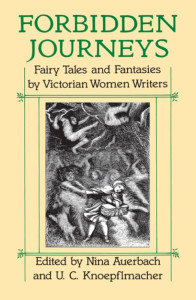 I was wearing my black Steeleye Span 30th Anniversary t-shirt as I wrote this look at folktales in the Anglo-Celtic tradition. The connection between that influential English folk rock group and the Anglo-Celtic Tradition folktales is simple – Steeleye Span, like many of the English groups of the late Sixties that electrified folk, took their material from those folk tales. Mr. Fox, New St. George, Maddy Prior, Fairport Convention – all mined the corpus of folk tales in the Anglo-Celtic tradition. (I originally was going to limit it to English folk tales, but there’s far too much cross-fertilization between the traditions to make a clean break between them.) For example, Steeleye Span has covered “The Demon Lover” and “Thomas the Rhymer,” Fairport Convention covered both “Tam Lin” and “Matty Groves,” and Mister Fox did a smashing job of retelling the Reynardine myth in their song “Mister Fox.” (See Mister Fox or Old Foister, a folk tale, for the complete and rather gruesome details.)
I was wearing my black Steeleye Span 30th Anniversary t-shirt as I wrote this look at folktales in the Anglo-Celtic tradition. The connection between that influential English folk rock group and the Anglo-Celtic Tradition folktales is simple – Steeleye Span, like many of the English groups of the late Sixties that electrified folk, took their material from those folk tales. Mr. Fox, New St. George, Maddy Prior, Fairport Convention – all mined the corpus of folk tales in the Anglo-Celtic tradition. (I originally was going to limit it to English folk tales, but there’s far too much cross-fertilization between the traditions to make a clean break between them.) For example, Steeleye Span has covered “The Demon Lover” and “Thomas the Rhymer,” Fairport Convention covered both “Tam Lin” and “Matty Groves,” and Mister Fox did a smashing job of retelling the Reynardine myth in their song “Mister Fox.” (See Mister Fox or Old Foister, a folk tale, for the complete and rather gruesome details.)
It is worth noting that “Tam Lin” may be the most covered of the folk tales. The Tam-Lin.org website notes “Tam Lin is probably the best-known of the traditional fairy ballads. In many ways, it is the canonical ballad. Featuring a maid named Janet, the Queen of Elfland, and a handsome hero imprisoned under the Hill; recorded by both Steeleye Span and Fairport Convention; turned into a picture book by Jane Yolen and a comong of age novel in the Fairy Tales series by Pamela Dean, it is also the inspiration for a raft of other beloved fantasy novels, including Diana Wynne Jones’s Fire and Hemlock, Elizabeth Marie Pope’s The Perilous Gard, Dahlov Ipcar’s The Queen of Spells, and Patricia McKillip’s Winter Rose (which blends the story of Tam Lin with elements of Christina Rossetti’s Goblin Market).” There is also an album by Blowzabella devoted entirely to the Tam Lin theme.
Forbidden Journeys: Fairy Tales and Fantasies by Victorian Women Writers is an interesting look at how different Victorian women writers were in terms of what they created. The editors note rightfully that Victorian women were less likely to idealize childhood, as their own childhoods were often less than perfect, so their fiction tended to be much darker than that of their male counterparts. (Worth briefly noting is Jack Zipes’s book Don’t Bet on the Prince: Comtemporary Feminist Fairy Tales in North America and England. It contains not only new and “revised” fairy tales, but a section of critical essays on, for instance, the history of the various versions of Little Red Riding Hood and the illustrations that accompanied them.) These tales form a seprate and quite literary tradition that has rarely been made public over the last hundred years.
Nina Auerbach in Forbidden Journeys writes:
Proscribed for its paganism by successive religious authorities, the orally transmitted fairy tale lingered in the popular imagination just as fays and gnomes had themselves presumably survived in the less populated regions of the British Isles. In literature written for children, however, such fantastic narratives had been forced to vie, for an entire century, with the moral fables preferred by even such eminent women educators as Maria Edgeworth, whose fine stories for children display her wariness of a demonic imagination. Even though French precieuses such as d’Aulnoy, L’Heritier, de Villeneuve and, eventually, a writer like Beaumont (whose 1756 Magasin des Enfans was actually printed in London) had penned fairy tales of their own, the earlier oral tradition of the contes de vieilles, or old wives’ tales, continued to be regarded as crude and subliterary. Not until the Romantic fascination with primitivism, childhood, and peasant folklore redirected collectors like the Grimms to female informants such as Dorothea Viehmann, did the genre’s rich mythical veins again become accessible, and its female origins become fully apparent to a dominant literary culture.
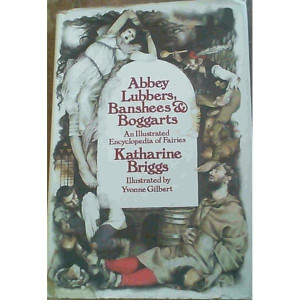 This is a book well-worth seeking out. The tales might not comfort you – indeed many such as those written by Christina Rossetti and Anne Thackeray Ritchie will give you a chill. Even the Christina Rossetti material will be unfamilar to most readers who know her only for Goblin Market. And the editors add footnotes – yes, this is an academic press title – that explain the more obscure references.
This is a book well-worth seeking out. The tales might not comfort you – indeed many such as those written by Christina Rossetti and Anne Thackeray Ritchie will give you a chill. Even the Christina Rossetti material will be unfamilar to most readers who know her only for Goblin Market. And the editors add footnotes – yes, this is an academic press title – that explain the more obscure references.
Abbey Lubbers, Banshees, & Boggarts isn’t at all about folk tales, but rather rather about those fey creatures who inhabit them. Written by the late Katherine Briggs, one of Britain’s most-knowledgable folklore schlors, this book is “Everything You Wanted to Know about the Fey Ones, but Were Afraid to Ask.” It covers every type of “little people” from abbey lubbers to trows. Not just the diminutive, luminous winged pixies of popular traditions, but brownies, goblins and bogies, even larger creatures that are less than friendly. And the explainations are grand – an abbey lubber is a minor devil that hung around abbeys where the monks were greedy and fond of the drink, and tempted the monks into commiting even greater acts of evil. The most famous was Friar Rush, an abbey spirit, sent from the infernal regions in the seventeenth century to keep the monks and friars in the same state of wickedness they were then in. And then there are boggarts. Boggarts, in their tattered and filfthy clothing, are nasty household spirits. They are usually recognized due to the unusual number of mishaps, sometimes fatal in nature, that occur while a boggart is in the house. No way is known in regards to the elimination of the boggart, except leaving the house, although sometimes this doesn’t even work, as boggarts are sometimes transported with household items. Susan Cooper in her Boggart series makes the creature more of a mild nuisance than an outright threat. Best of all, each page has wonderful illustrations by Yvonne Gilbert who brings into being the creatures that Briggs describes. If this book tickles your fancy, look for her Encyclopedia of Faeries which is an expanded version of this work.
British Folktales and Folktales of England are more traditional approches by Katherine Briggs to the rich lore of British folk tales. Culled from her massive Dictionary of British Folktales, ghosts, giants, devels, dragons, saints, kings, and commoners jostle on each page as they tell their tales. Richard Adams, author of Watership Down, Shardik, and other novels, called her “the magic mirror on the wall.” This is the really good stuff that nightmares are made of: specter bridegrooms, dragons, giants, devils (see devils in Robert Hunt’s Popular Romances of the West of England; or, The Drolls, Traditions, and Superstitions of Old Cornwall for the gory details,) wee green men, and many other beings that go bump in the night. One source noted “Folk narrative is defined by the author as “folk fiction, told for edification, delight or amusement,” whereas folk legend “was once believed to be true.” All these tales are told as if they were indeed true – and some are quite fantastical. Folktales of England is made more interesting for the inclusion of several musical scores for songs that were based on the old tales. Not surprisingly, “Mr. Fox’s Courtship,” a variant on the song “Mister Fox,” is here, as is “Little Rosy,” a variant of the much better known Grimm Brothers tale “The Juniper Tree.” There are extensive notes on who told the tale as well as where the teller got the tale from. This book at this writing was still in print in the United Kingdom.
The Times Literary Supplement says Kevin Crossley-Holland’s edited collection Folk Tales of the British Isles is “An exuberant celebration of the storytelling impluse, a marvelous introduction to the rich and varied storytelling tradition of the British Isles.” The editor is both a well-known mythologist and a children’s book author. Here he draws upon the centuries old tales of the intertwined Celtic, British, and Nordic traditions to give us sixty-seven tales to read long into the night. As he quotes in his foreword:
The grey old man in the corner
Of his father hear a story
Which from his father he had heard,
And after them I remembered.(Trad., translated from the Welsh)
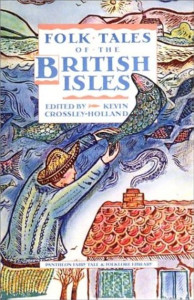 These are stories handed down from generation to generation across the centuries. (Folk musicians use this motif too – “The Oxford Girl” by the Oysterband developed as a reflection of these tales. Crossley-Holland has done a bloody good job of collecting tales both well known and hardly known at all. Alongside Sir Walter Scott’s “The Young Tamlane” is the rarer “The Dragon of Wantley,” as translated by Jacqueline Simpson, and Joseph Crandall’s “The Fox and the Wild Goose.” Capping off this most splendid book is “Why Everyone Should Be Able to Tell a Story,” John Lorne Campbell’s short cautionary tale of what happens to someone who can’t tell a proper tale. I’d say this collection is essential for anyone seriously interested in Anglo-Celtic folktales.
These are stories handed down from generation to generation across the centuries. (Folk musicians use this motif too – “The Oxford Girl” by the Oysterband developed as a reflection of these tales. Crossley-Holland has done a bloody good job of collecting tales both well known and hardly known at all. Alongside Sir Walter Scott’s “The Young Tamlane” is the rarer “The Dragon of Wantley,” as translated by Jacqueline Simpson, and Joseph Crandall’s “The Fox and the Wild Goose.” Capping off this most splendid book is “Why Everyone Should Be Able to Tell a Story,” John Lorne Campbell’s short cautionary tale of what happens to someone who can’t tell a proper tale. I’d say this collection is essential for anyone seriously interested in Anglo-Celtic folktales.
Now let’s look at Folk Tales of the British Isles. Eh? Yes, another book with the same title, but this time by Michael Foss, author of Traditional Nursery Rhymes. Like the previously discussed volume, this collection has tales from Wales, Ireland, Scotland, and England itself. Sea-based dramas of the Vikings as well as the jovial giants of Somerset, and the wee folk of Ireland are here. Elfish homor is here as well as outright horror. Like the Katharine Briggs’ Abbey Lubbers, Banshees, & Boggarts, this volume has great illustrations – this time by Ken Kiff. If you want to see what the tales in here are like, check out “Tattercoats.” There is – as always in any body of tales – duplication between these two books. I’d say that Kevin Crossley-Holland has done a better job of seeking out rarer texts, but Foss has excelled at finding the commonalities in the Anglo-Celtic tradition of the 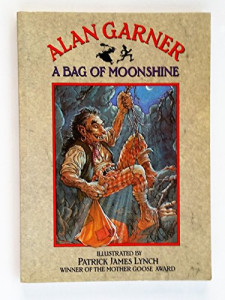 familar French and German tales of Perrault and Grimm. Both editors have done a splendid job of mixing print and oral traditions, but neither bothers to truly document the origins of the tales in the way Briggs does in Folktales of England.
familar French and German tales of Perrault and Grimm. Both editors have done a splendid job of mixing print and oral traditions, but neither bothers to truly document the origins of the tales in the way Briggs does in Folktales of England.
Alan Garner is both a collector of folk tales and a damn fine fiction writer. His novel The Owl Service, a brillant reworking of The Mabinogion, has been a core text of young adult literature for over thirty years. These two collections, A Bag of Moonshine and Book of British Folk Tales, are essential parts of any serious folklore collection. (My darling wife Brigid traded a baker’s dozen of her mincemeat pies for A Bag of Moonshine.) Garner says that he has “tried to place my literate ear in the way of a preliterate voice, so that, although the word in the air is not the same word on the page, the force may be recreated and felt.” In both of these collections he has succeeded in imbuing them with the feel of a storyteller up against the fireplace on a cold, rainy night. (The illustrator, James Patrick Lynch, was awarded the 1987 Mother Goose Award “for the most exciting newcomer to British children’s book illustration” for this book.) Children of all ages will appreciate these tales of boggarts, gowks (a spectacularly dumb idiot), hobgoblins, changeling salmon, babies driven to dance madly by fiddle music, ladies of the lake, and wee not-so-green men who badly mislead travellers late at night.
These are truly the work of a master storyteller. My description of A Bag of Moonshine is equally appliciable to his Book of British Folk Tales. Different tales, same approach – the only meaningful difference is that the latter book has illustrations cut and drawn – yes, true woodcuts! – by Derek Collard.
Flora Annie Steel’s English Fairy Tales was clearly intended for children, but it’s still worth seeking out. Steel (1847-1929) was one of the great Victorian collectors of fairy tales. (The less said about her novels the better. See The Potter’s Thumb for a look at her prose.) English Fairy Tales is a large and rather delightful collection of fairy tales in straight forward, easily readable prose. There are no surprises here – just good reading: “The Three Bears,” “Little Red Riding Hood,” “Jack the Giant Killer,” “The Three Little Pigs,” and othe classic tales are here. And the illustrator is Authur Rackham, who created the drawings for the 1918 edition.
On a circle of stones they placed the pot,
On a circle of stones but barely nine;
They heated it red and firey hot,
Til the burnished brass did shimmer and shine.They rolled him up in a sheet of lead,
A sheet of lead for a funeral pall;
They plunged him in the cauldron red,
And melted him, lead, and bones, and all.Leyden’s ballad of “Lord Soulis” – recounted in Albion: A Guide to Legendary Britain
Jennifer Westwood’s Albion: A Guide to Legendary Britain is a core reference work for anyone interested in the legends of Britain. How good is it? Would you 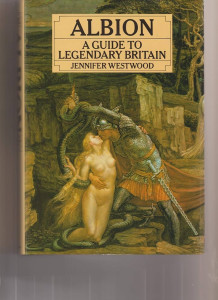 believe that it even has the tale that inspired the creation of the legendary Anglo-Celtic folk rock group Boiled in Lead? (See lyrics above.) What Westwood has done is place the tales within their proper geographical location. So Leyden’s ballad of “Lord Soulis” which Boiled in Lead borrowed its name from is not just a tale, but rooted in the border between Scotland and England. The poor unfortunate being being boiled alive is not some peasant, but rather the familar of the landlord who – if I read this correctly – was wreaking mischief upon the peasants. Stripped of his powers, his end was very gruesome. What we get is the evolution of the tales as they come into being, evolve over the many years, and now are cherished by storytellers. Westwood did a superb job of finding many a lost tale by delving into dusty medieval chronicles, journals of Victorian folklorists, and by asking the locals what they remembered. All tales evolve over time as the actual event gets fused with oother tales, and as time erases the original memories. This book is out of print, but look for it ’til you find it.
believe that it even has the tale that inspired the creation of the legendary Anglo-Celtic folk rock group Boiled in Lead? (See lyrics above.) What Westwood has done is place the tales within their proper geographical location. So Leyden’s ballad of “Lord Soulis” which Boiled in Lead borrowed its name from is not just a tale, but rooted in the border between Scotland and England. The poor unfortunate being being boiled alive is not some peasant, but rather the familar of the landlord who – if I read this correctly – was wreaking mischief upon the peasants. Stripped of his powers, his end was very gruesome. What we get is the evolution of the tales as they come into being, evolve over the many years, and now are cherished by storytellers. Westwood did a superb job of finding many a lost tale by delving into dusty medieval chronicles, journals of Victorian folklorists, and by asking the locals what they remembered. All tales evolve over time as the actual event gets fused with oother tales, and as time erases the original memories. This book is out of print, but look for it ’til you find it.
